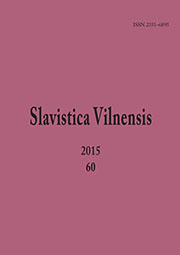Lenkų kalba Semeliškių apylinkėse: leksikos ypatumai
Polish language in the surroundings of Semeliškės: lexical peculiarities
Author(s): Alina Pacino, Kristina RutkovskaSubject(s): Lexis, Comparative Linguistics, Western Slavic Languages, Philology
Published by: Vilniaus Universiteto Leidykla
Keywords: Polish language in Lithuania; lexis; borrowings; language contacts;
Summary/Abstract: The article deals with the Polish language features common in Semeliškių surroundings. This area belongs to the West region of Vilnius dialects, which is characterized by regressive, or minimal, bilingualistic type. Such variation of the Polish language is used by the old and only a small part of the middle generation. Only very rarely is this language used to interact in a public environment, Lithuanian language is more common. Primary schools, where the teaching language was Polish, were common in these areas only during the interwar period. Currently only Lithuanian educational institutions are in place. Residents of these dialectical areas know the Russian language, especially prevalent during the heyday of Soviet farms; the Belarusian language is also common. Features of the Polish language are described in the lexical basis. Lexis reflects well both Lithuanian language substrate, as well as the later adstratic and superstratic layers. Separated from the general Polish language, Polish dialects in the region managed to maintain Polish archaisms over time, lexical lituanizms, which entered the Polish dialects in different periods and in different ways, are widely prevalent. The old Lithuanian language borrowings can create synonym doubles with nearby used Polish archaisms, old baltarusisms, rusisms.
Journal: Slavistica Vilnensis
- Issue Year: 60/2015
- Issue No: -
- Page Range: 75-86
- Page Count: 12
- Language: Lithuanian

